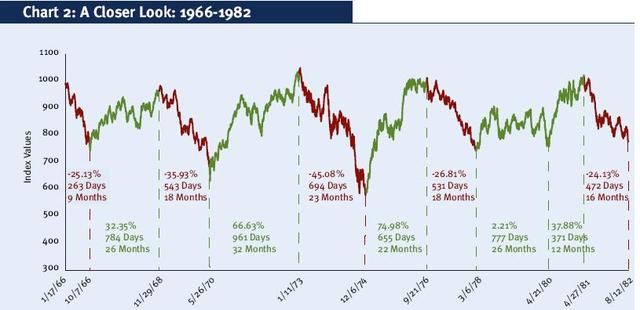The previous chart reveals the long standing secular moves of the markets; What’s an investor to do during one of the long periods of weakness?
One answer is to learn to be more nimble, and trade the cyclical markets.
>
Dow Jones Industrial Average, 1966 – 1982
click for larger chart

data for chart courtesy of Bloomberg
>
During this period, we see rallies as much as strong as 75% and sell offs as brutal as 45%.
This is not a goo9d environment for the Buy and Hold approach. It works well ONLY during secular — not cyclical — Bull phases. You can hold stock for decades if you buy into the early stages of a secular period. Think of the years right after 1935, 1946 or 1982. But if you by at the wrong end of a secular run — 1929, 1966, or 2000 — and it took many years to get back to breakeven; and thats before inflation:
1929 purchase breakeven = 1954 (25 years)
1966 purchase breakeven = 1982 (16 years)
2000>(breakeven = ?)
History suggests that a top ticking Nasdaq holder will not return to breakeven — 5100 — until between 2015-25
>
Source:
Investing —More of a Challenge
Rydex Funds
http://www.rydexfundsfp.com/pdf/ium_6pager.pdf



Great idea if the timing works out. Can you point to many money managers who consistently were able to profitably time the movements of the broad market over a decade after accounting for transaction costs and tax effects?
Bill Dunn (Dunn Capital)
John W. Henry
Ed Seykota
Richard Donchian
Richard Dennis
Louis Bacon
Tom Baldwin
Tom Basso (Trendstat Capital Management)
Peter Borish (Twinfields Capital Management)
Leon Cooperman (Omega Advisors)
Richard Driehaus (Driehaus Capital Management)
Stanley Druckenmiller
Kenneth C. Griffin (Citadel Investment Group)
Blair Hull (the Hull Group)
Paul Tudor Jones
Mark Kingdon (Kingdon Capital Management)
Bruce Kovner (Caxton Corporation)
Bill Lipschutz
Michael Marcus
William O’Neil
Randy McKay
Mark Ritchie (Citadel Investment Group)
Marty Schwartz
Jim Simons (Renaissance Technologies)
James B. Rogers, Jr (Quantum Fund)
George Soros (SorosTrading)
Victor Sperandeo
Michael Steinhardt
Julian H. Robertson Jr., (Tiger Management)
Monroe Trout
you get the idea . . .
It is not just a question of timing the market.
It is also a question of portfolio composition.
In a rising phase you want to overweight your portfolio in high beta growth stocks and in a falling phase you need to reverse this and overweight your portfolio in low beta stocks.
But the first step is to correctly recognize the environment and adjust your thinking to the point
that buy and hold will not work.
At a minimum recognize that growth will not consistently outperforming value.
Barry:
I do now. Can you point me towards the ones who will be able to make money over the next ten years?
royce: Do you also want Barry to cut your meat?
Sprott Asset Mgmt. has a very well researched and sourced piece about possible market manipulation.
The Visible Hand (pdf)
Remember when the Dow bounced off the 10,000.46 mark earlier this year!?
Would be interesting to see this adjusted for inflation.
I’m a novice investor … but my strategy is to keep my funds in short term treasuries until the next “fire sale” in the stock market.
Is that a reasonable plan? Also, how do I know when the stock indexes are truly a bargain?
That might be a decent plan —
but you always need a back up, just in case there is no fire sale.
As to your 2nd question, go back and look at the history of past “fire sales” — what were the conditions like?
In 1982, the P/E ratio of the S&P500 was under 10;
In October 2002, I noticed that some profitable tech stocks were selling for less than cash on hand — the market had determined that a dollar was actually only worth 80 cents.
“History suggests that a top ticking Nasdaq holder will not return to breakeven — 5100 — until between 2015-25”
Why? If someone owns and had owned QQQQ, doesn’t that statement assume no changes in the index? Only problem with my own question is that the good people who decide the components put in stocks that have had big runs in favor of those that are $1.
Ah!!…a turtle fan you are!
I trade options on the Q’s for a living. Timing is one of several impliments I use to trade. Intuition plays a big part in it too.
A lot of $ can be made by buying and selling within a trend. Of course, the Turtle’s have a different strategy, and it works! But then, so dose mine.